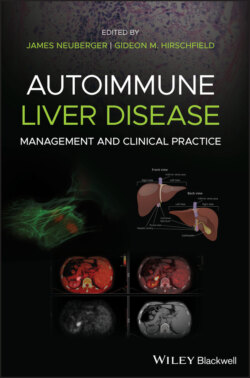Читать книгу Autoimmune Liver Disease - Группа авторов - Страница 38
Cholestasis
ОглавлениеCholestasis is an overarching term applied to conditions in which there is impairment of bile formation and/or bile flow. It occurs where there is a failure at any point along the biliary tree, between the basolateral (sinusoidal) membrane of the hepatocyte and the ampulla of Vater, as a result of congenital or acquired injuries, that leads to impaired secretion of bile such that biliary constituents spill into blood. It may result from (i) hepatocellular and/or cholangiocellular secretory defects or (ii) obstruction of bile ducts by bile duct lesions, stones or tumors, but may also be related to mixed mechanisms in conditions such as PBC or PSC.
ALP and GGT are markers of cholestasis. ALP is a ubiquitous membrane‐bound glycoprotein that catalyzes the hydrolysis of phosphate monoesters at basic pH values. Liver and bone are the major source of serum ALP. The liver isoenzyme is located on the canalicular side of the hepatocyte plasma membrane and the luminal surface of bile duct epithelium. Serum ALP elevation more than three times normal strongly suggests cholestasis if bone disease is absent and GGT is elevated. In patients with cholestasis, the ALP elevation is triggered by increased synthesis and release of the enzyme into serum rather than impaired biliary secretion. BAs build up in hepatocytes and solubilize the plasma membrane, thereby resulting in release of ALP. The half‐life of serum ALP is 5–7 days, and therefore serum ALP remains elevated for several days after resolution of the biliary obstruction. ALP is not used as a marker of cholestasis in adolescent and pregnant women since ALP in these conditions can be raised as a consequence of rapid bone growth and placental growth. Chronic renal failure can result in elevation of the intestinal ALP isoenzyme. In patients with raised ALP, hyperthyroidism should be ruled out. Rarely, ALP can be identified in patients with underlying malignancy not involving either liver or bones. This is the Regan isoenzyme, biochemically different from the liver isoenzyme, that has been described in lung cancer, Hodgkin disease, and renal cell carcinoma. Finally, ALP should be tested after fasting since its level can rise after a fatty meal.
GGT is an enzyme that can be induced by several stimuli such as drugs and alcohol. It is mainly localized in hepatocytes and biliary epithelia, and is also present in extrahepatic tissues such as kidney, spleen, pancreas, heart, lung, and brain, but not bone. The lack of GGT in bone can be used to distinguish a liver source from a bone source of a raised ALP. GGT is more liver specific than ALP, although during cholestasis is less specific since it can be influenced by other factors such as alcohol, fat, and drugs. A GGT/ALP ratio over 2.5 may point to alcohol abuse, although up to one‐third of those who abuse alcohol (>80 g/day) have a normal GGT. A normal GGT in patients with elevated liver ALP isoenzyme should raise the suspicion of benign recurrent intrahepatic cholestasis.
